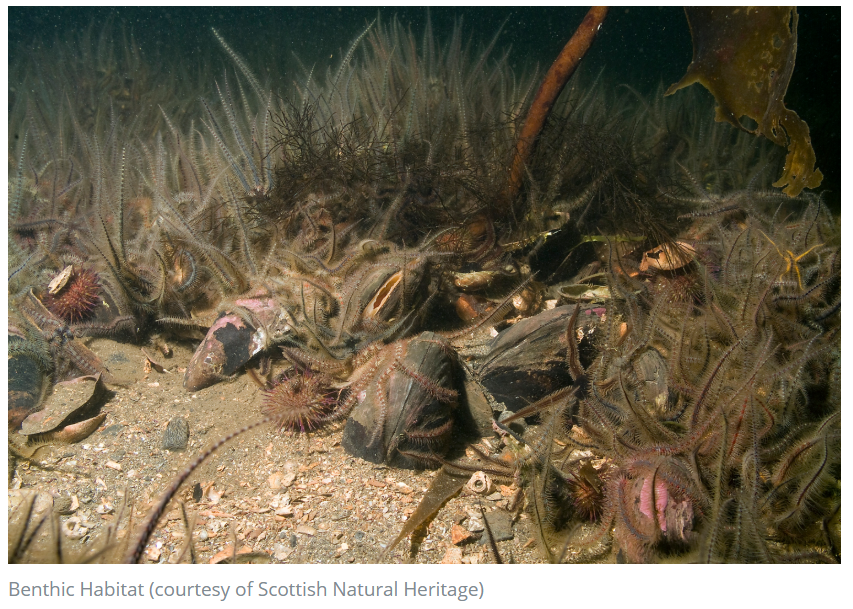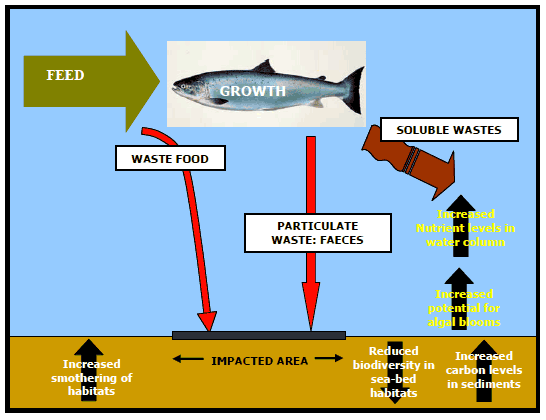Benthic surveys are a good way to understand the impact that fish farms have, and are having, on loch or seabeds, and associated habitats and species. So, what are benthic surveys and why are we bothered?
What are benthic surveys and why are they important?
The term ‘benthic’ refers to the lowest ecological area in a body of water, known as the ‘benthos’. When examining benthic surveys completed in relation to salmon farming, this is a measure of the loch or seabed directly underneath the farm.
The reason that Fidra are interested in benthic surveys from salmon farms is because the results are a good indication of the impact the farm may be having on nearby habitats and species. Additionally, benthic habitats are essential for marine life because all species rely, directly or indirectly, on the benthos to feed, rest or reproduce[1]. The condition, or ‘quality status’, of benthic habitats reflects the combined effects of all the pressures to which they are subject[2], offering information about the species (animal or plant), types and quantities of chemicals present, and oxygen levels, to list just a few measurables.

©SNH
The impacts of salmon farms on benthos
Where some farms have been in production for extended periods of time, have a high biomass (tonnage of salmon), and where chemical treatments are required, it is not unusual to see poor benthic survey results. This is primarily as a result of the high levels of waste that are deposited on the loch or seabed floor, smothering it, and subsequently reducing the levels of oxygen required for life to survive.
As Scottish Environmental Protection Agency (SEPA) and other stakeholders acknowledge the inevitable impact from salmon farms on the benthos, there is an Allowable Zone of Effect (AZE), which refers to “the area (or volume) of seabed or receiving water in which SEPA will allow some exceedance of a relevant Environmental Quality Standards (EQS)”[3]. It is worth noting that the benthic surveys are completed in the AZE alone. Therefore, if there are impacts outside the AZE, they would likely be missed, or if impacts were to fall into the AZE of another farm they would be attributed to this site rather than the actual source.
In a report led by the Marine Conservation Society (MCS), they refer to the AZE as an area where “SEPA will allow…some damage to the environment”[4]. As an environmental charity, we sympathise with MCS’ view and continue to hold a focus on this area through our Best Fishes project.
Working out the AZE
SEPA use a form of modelling to account for how far the AZE may be for each farm, setting varying limits based on the volume and types of discharge from each farm, and the directional currents etc. From this, SEPA are able to predict whether, and to what extent, the EQS may be violated.
Community group and registered charity, Friends of the Sound of Jura, provided the Environment, Climate Change and Land Reform (ECCLR) Committee with a report on the ‘Environmental impacts of salmon farming’, which clearly details their concerns on the quality of the seabed around Jura. This document specifically responds to the proposition of a new site and highlights the failing of SEPA’s modelling which assumes the loch or seabed affected to be flat. Indeed, the report describes how the site for a proposed new farm “slopes steeply”, therefore increasing the AZE as waste falls away from the site.
SEPA are currently looking at a new form of modelling which ought to take irregularities in the structure of the loch or seabed into consideration.

SOURCE: Scottish Marine and Freshwater Science Vol. 3 No. 6
How can farms be ‘good’ if the benthos is poor?
From looking at the data available on the Scotland’s Environment website, Fidra understands that some farms have received years of poor benthic survey results. Not only are these farms still in production, without any clear sign of repercussions as a result of these poor surveys, but they have also been deemed ‘good’ or ‘excellent’ according to SEPA’s Compliance Assessment Scheme.
Data available on Scotland’s Environment shows that one farm has had 8 benthic surveys conducted between 2006 and 2019. The first 7 benthic surveys were deemed ‘Unsatisfactory’, with the most recent (completed 13.04.2019) receiving a ‘Borderline’ result. Fidra is interested to understand how the farm received a compliance standard of ‘Good’ in 2015 and 2018 from SEPA, when the benthic surveys are ‘unsatisfactory’.
This is not a standalone example. We found another farm that had 2 ‘Satisfactory’ benthic survey results in 2004. Since then, it received 4 ‘Unsatisfactory’ results, and one which was ‘Unclassified’. Despite this, the farm was offered a ‘Good’ level of compliance from SEPA in 2015, with no explanation regarding why this was despite poor benthic results. We also found that this farm was fallow (empty) from 2016-2019, yet the data suggests that no benthic surveys were conducted at the start, during, or since this fallow period, therefore not documenting any changes to what were deemed poor benthic conditions. Despite this lack of benthic survey data this farm re-commenced production in 2019 and was provided an ‘Excellent’ SEPA compliance standard in 2018.
Concluding through the contradictions
If a ‘poor’ benthic survey result can come from a farm deemed to be ‘good’ on compliance by SEPA, it begs the questions: What are the repercussions as a result of poor performance in benthic surveys? Are the monitoring processes fit for purpose? And how much do we value our seabeds and the creatures that rely on them?
Fidra continue to call for increased transparency through an online Sustainability Dashboard to present the data clearly and openly, and to piece together an understanding of the true impacts of salmon farms.
As SEPA are relaxing compliance during the Covid 19-induced lockdown, Fidra would like to see information produced on the cases that are brought to them from farms that feel unable to meet the current compliance standards. Perhaps this period of lockdown could provide some time for SEPA, and associated stakeholders, to scrutinise their current processes and create a more holistic approach to qualifying the environmental performance of salmon farms in Scotland, alleviating further harm on our unique landscapes and species.
Read our blog about our concerns regarding SEPA’s decision to relax some compliance regulation processes.
[1] https://oap.ospar.org/en/ospar-assessments/intermediate-assessment-2017/biodiversity-status/habitats/condition-of-benthic-habitat-defining-communities/common-conceptual-approach/
[2] https://oap.ospar.org/en/ospar-assessments/intermediate-assessment-2017/biodiversity-status/habitats/condition-of-benthic-habitat-defining-communities/common-conceptual-approach/
[3] https://www.sepa.org.uk/media/113511/fish-farm-manual-annex-h.pdf
[4] https://www.mcsuk.org/media/seafood/614-2017MarineAquacultureConsentingGuideA4.pdf
Tags: benthic, covid-19, pollution, Scottish salmon farming

